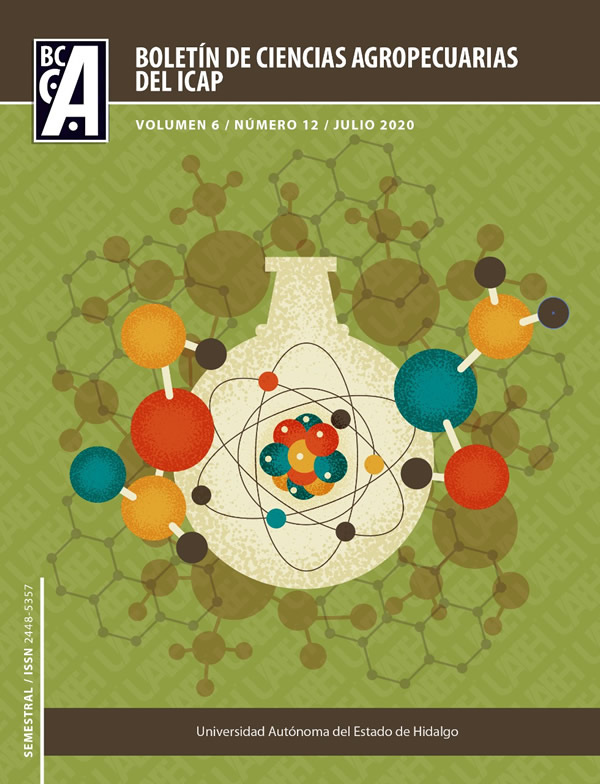Biological activity in vitro of the aqueous extract of Argemone mexicana L. in a phytopathogenic fungus: Sclerotinia sclerotiorum
Abstract
Sclerotinia sclerotiorum is a phytopathogenic fungus that causes the disease known as cotton rot that infects crops of agronomic interest. The objective of this study was to evaluate the antifungal activity of the aqueous extract of Argemone mexicana L. commonly known as chicalote against Sclerotinia sclerotiorum, the extract was obtained from the leaves of chicalote and three concentrations were tested: 500, 1000, 2000 ppm, using the dilution method of the extract in agar, in addition the mean lethal concentration (LC50) of the extract was determined by means of a Probit analysis. The 2000 ppm concentration presented the highest percentage of inhibition (27.24 ± 0.01%, Tukey P ≤ 0.05) and an LC50 of 33,515 ppm. This result suggests the use of the aqueous extract of A. mexicana L. as a preventive alternative for the control of Sclerotinia sclerotiorum.
Downloads
References
Abawi, G., & Grogan, R. (1975). Source of primary inoculum and effects of temperature. J. Phytopathol., 65, 300-309.
Abdel-Monaim, M. F., Abo-Elyousr, K. A. M., & Morsy, K. M. (2011). Effectiveness of plant extracts on suppression of damping-off and wilt diseases of lupine (Lupinus termis Forsik). Crop protection, 30(2), 185-191.
Wilson, C. L., El-Ghaouth, A., & Wisniewski, M. E. (1999). Prospecting in nature’s storehouse for biopesticides. In Conferencia Magistral Revista Maxicana de Fitopatologia (Vol. 17, No. 1, pp. 49-53).
Barrera-Necha, L. L., & Bautista-Baños, S. (2008). Actividad Antifúngica de Polvos, Extractos y Fracciones de Cestrum nocturnum L. Sobre el Crecimiento Micelial de Rhizopus stolonifer (Ehrenb.: Fr.) Vuill. Revista mexicana de fitopatología, 26(1), 27-31.
Bravo, L. L.; T. Bermúdez y B. Montes. 2000. Inhibición de Fusarium moniliforme mediante polvos vegetales y algunos de sus componentes químicos. Manejo Integrado de Plagas 57: 29-34.
Contreras-Arredondo, M. E., Hernández-Castillo, F. D., Sánchez-Arizpe, A.,Gallegos-Morales, G., & de Rodríguez, D. J. Actividad Fungicida de extractos de Cowania plicata contra Fusarium oxysporum y de Pistacia lentiscus L. contra Colletotrichum coccodes. Revista Agraria-Nueva Epoca-Año VIII· Vol, 8(1), 2011.
Hernández- Soto I., Prieto-Méndez J., Aquino Torres E., Madariaga Navarrete A., Reyes Santamaría M. I., Pacheco Trejo J. Evaluation of the effect of the methanolic extract of Argemone ochroleuca for environmentally friendly control of Colletotrichum gloeosporioides, Fusarium oxysporum and Rhizoctonia solani. Ciência e Técnica Vitivinícola, Vol. (33), 2018.
Cowan, M. M. (1999). Plant products as antimicrobial agents. Clinical microbiology reviews, 12(4), 564-582.
Lagrouh, F., Dakka, N., & Bakri, Y. (2017). The antifungal activity of Moroccan plants and the mechanism of action of secondary metabolites from plants. Journal de mycologie medicale, 27(3), 303-311.
Delgado Ortiz, J. C., Ochoa Fuentes, Y. M., Beltrán-Beache, M., & Cerna Chávez, E. (2018). Evaluación in vitro de la actividad antifungica del extracto de Heliopsis longipes en cepas de Sclerotium cepivorum y Sclerotinia sclerotiorum. Revista mexicana de ciencias agrícolas, 9(4), 871-877.










